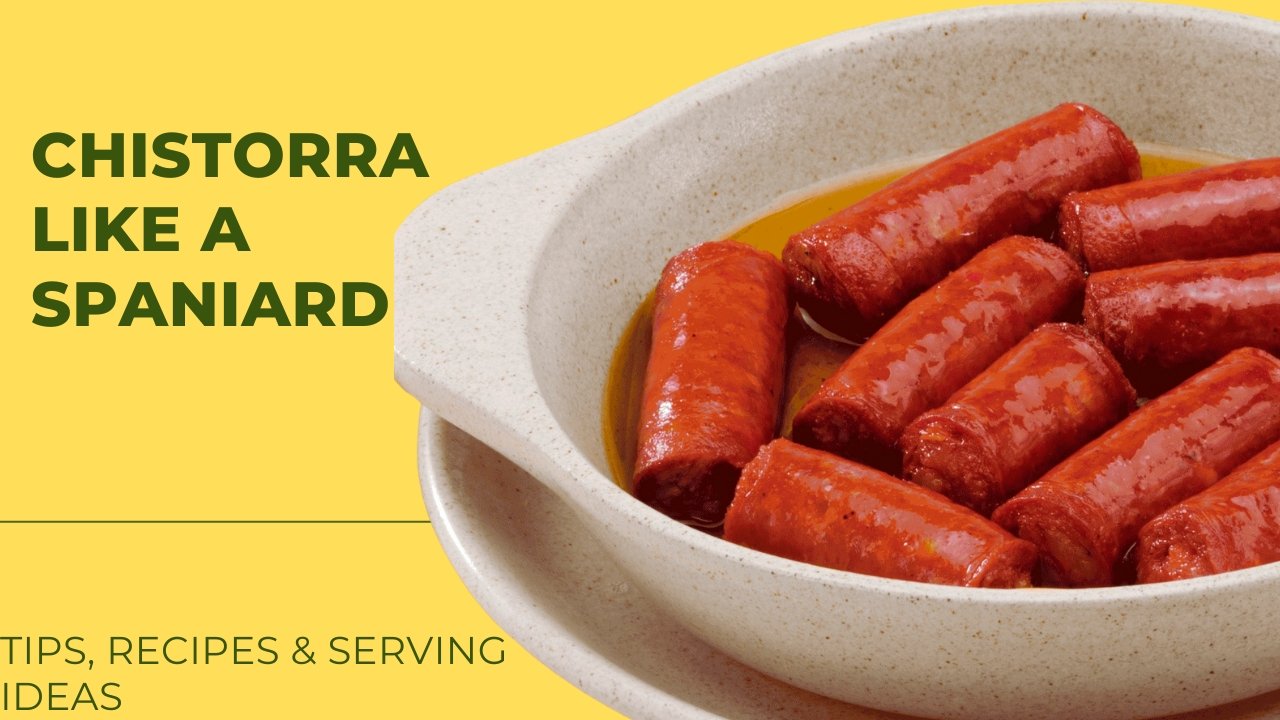Chistorra is a sausage. If you are trying to enjoy something very special, try chistorra for its bursting flavour. The taste of sausages is so satisfying and comforting. Unlike other sausages, Chistorra is a fast-cure or semi-cure.
It is encased in a natural lamb gut or a collagen casing. It originates from the Navarra and the Basque regions of Northern Spain. It is made up of pork, paprika, garlic, and a mix of aromatic spices. Its colour is deep red and is very rich in taste and juicy texture. It is generally not eaten raw. Typically baked, fried or grilled. It is often served as a tapa or sandwich.
In this blog post, you will learn how to cook chistorra. It has such simple methods to prepare. Many serving tips or ideas to share with you. Let’s get started!
Table of Contents
What Is Chistorra?
Chistorra is a thin, paprika-rich Spanish sausage. It is long and slender, and usually cooked quickly. The skin is very crispy, and inside there is a burst of flavours. It has a much shorter maturation process. It is thinner than chorizo, diameter of about 25mm and coiled up.
Traditionally, it is made by local butchers. It has a simple mix of spaces and an intense aroma, making it perfect for cooking. It serves as a tapa. You can serve it as a stuffed bread, or paired with potatoes for a hearty meal. It is a favourite in both traditional Spanish kitchens and modern tapas bars around the world.
Chistorra and chorizo share some similarities. Chistorra is thinner, longer or fresh. It must be cooked before eating. Chorizo is generally thicker or fresh, and ready to eat. It has a milder taste.
How to Choose the Best Chistorra
When we talk and look at the best chistorra, some quality ingredients and indicators reflect in our mind. Here are some perfect picks for perfect sausage:
Freshness Tips
A high-quality chistorra will have a bright colour like the paprika (Pimenton). There is a lack of colour when it has no quality ingredient. Traditionally, it is stuffed into natural lamb casing. The casing should be smooth, without cracks or dryness. If it is sold fresh, then check it by gentle pressing; it should feel firm. If there is a packaged version, check the use-by dates.
Where to Buy
It is available in the food markets, whether locally or imported from Spain. Many gourmet butchers also carry it. Many online stores sell fresh and vacuum-packed chorizo. Make sure to use chilled packaging for freshness.
✨ “Fideuà is paella’s pasta cousin — a golden, saffron-infused dish that captures the true flavor of Spain’s coast.” 🦐🍋🇪🇸
Basic Ingredients
- 500 g fresh Chistorra sausage
- 1 tbsp olive oil
- Optional sides: crusty bread, roasted potatoes, or fried eggs
Step-by-Step Instructions
1. Prepare the Chistorra
- Defrost the chorizo from the fridge 15–20 minutes before cooking.
- We have to reach chistorra at room temperature.
- Chistorra should cook evenly and keep the casing from bursting.
2. Heat the Pan
- Place a non-stick pan over medium heat. You can also use a cast-iron pan.
- Add 1 tbsp olive oil, which is extra virgin.
- Warm it for about 1 minute.
3. Cook the Chistorra
- Place the sausages in the pan. Avoid overcrowding.
- You have to cook those for about 4–5 minutes on each side, turning occasionally.
- After some time, you will see the change in colour of chistorra, it releases paprika-coloured oil.
4. Check for Doneness
- Chistorra must be cooked properly, crispy on the outside and fully cooked on the inside. Avoid the pink colour.
- We have to maintain the temperature when it reaches 70°C / 160°F internally.
5. Serve the Spanish Way
- Remove the excess oil by using a paper towel.
- It should be served hot with crusty bread.
- If you pair these, it looks like a full meal.
Tip: Chistorra can also be grilled or baked, but pan-frying is the most traditional way in Spain because it intensifies the smoky paprika flavour.
Serving Ideas & Pairings
Chistorra is incredibly versatile. It is a part of a Spanish tapas meal. It is included in a festive tapas spread. Here are some Spanish pairing or serving ideas:

- Crusty Bread
- Fried or Roasted Potatoes
- Spanish Omelettes (Tortilla)
Wine & Drink Pairings
In Spain, it is enjoyed with the following rinks:
- Young red wines
- Cider (sidra)
- Beer
- Sangria

Tips for the Perfect Chistorra Every Time
To give chistorra perfection is all about heat, without burning from the outside or losing its juicy characteristics. By following these tips, you will enjoy its charm.
Avoid Overcooking
It cooks slowly; choosing medium heat is best. If you use high heat, it will burn from the outside. A moderate, perfect temperature is the best. Please stick to the medium heat until it gets golden-brown.
Let It Rest Before Serving
Chistorra needs a short resting time. Once it is cooked, set aside for 1-2 minutes. This keeps the sausage moist and flavourful. By resting, it redistributed the juiciness.
Enhance Flavour with Herbs or Sauces
You can enhance flavour by using herbs and sauces:
- Fresh herbs like rosemary or thyme. You can toss it in the pan during cooking. It infuses the aroma.
- Sauces such as alioli (garlic mayo), bravas sauce, or a drizzle of chimichurri complement its richness.
- You can squeeze fresh lemon. It brightens the flavour.
Conclusion
Chistorra is a distinctive Spanish sausage. It is celebrated for its bright red colour. Its every bite is filled with smoky paprika, garlic, and juicy flavour. There were deep roots in the Navarra and the Basque Country. It is the favourite tapas in the home kitchen.
To enjoy chistorra, it should be cooked, whether pan-fried, grilled or baked. It is always flavourful, smoky, crispy and juicy. Chistorra is a delicious and essential part of Spanish cuisine. Chistorra is a comforting and satisfying sausage you must try. Enjoy this with your family, friends and your loved ones! Share the reviews with me.










